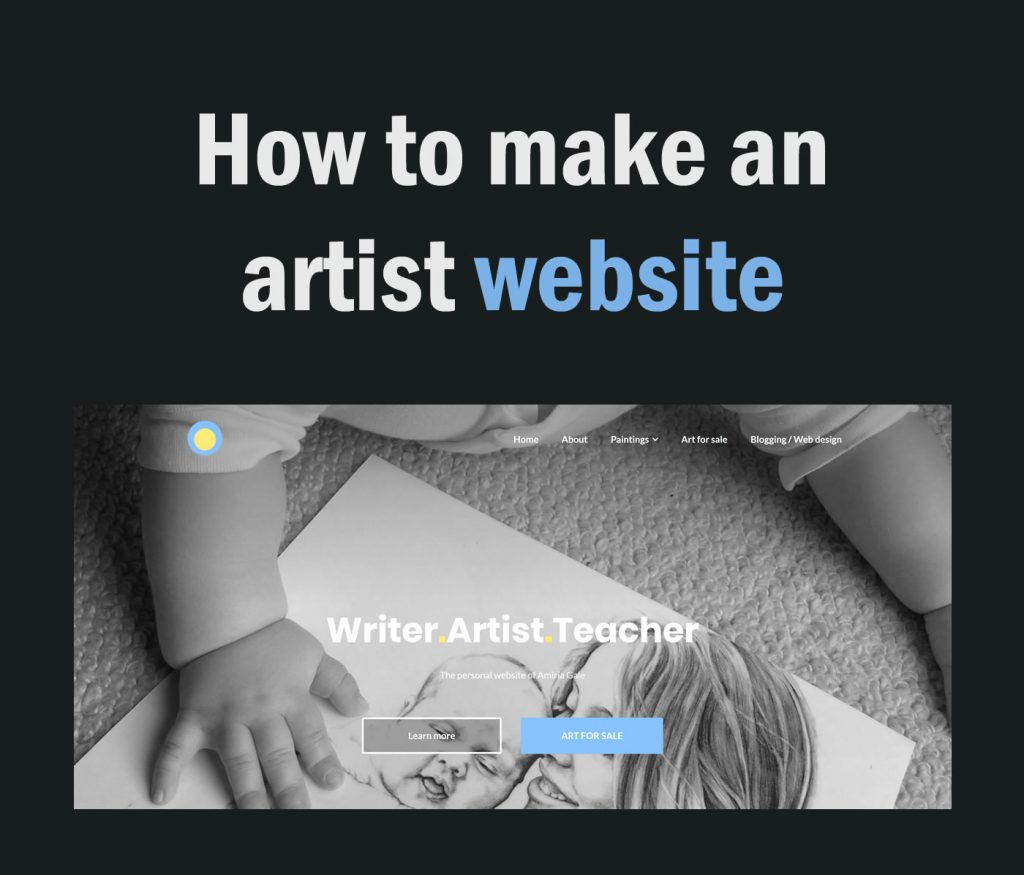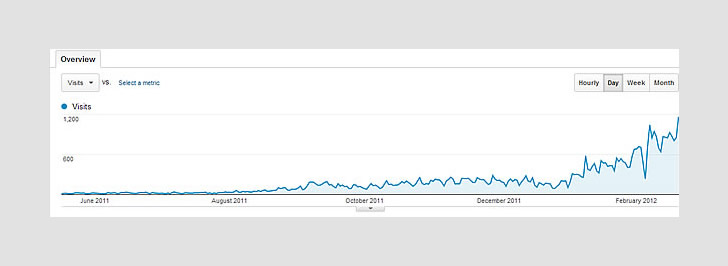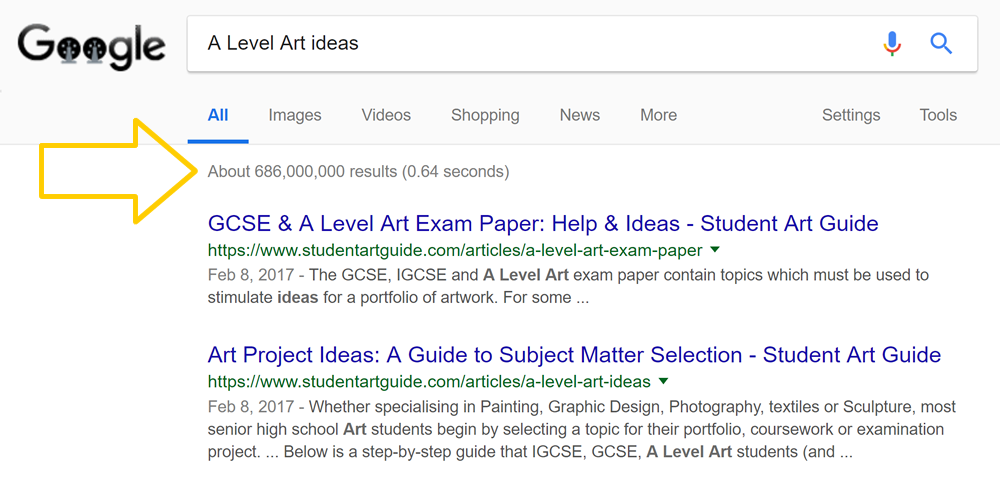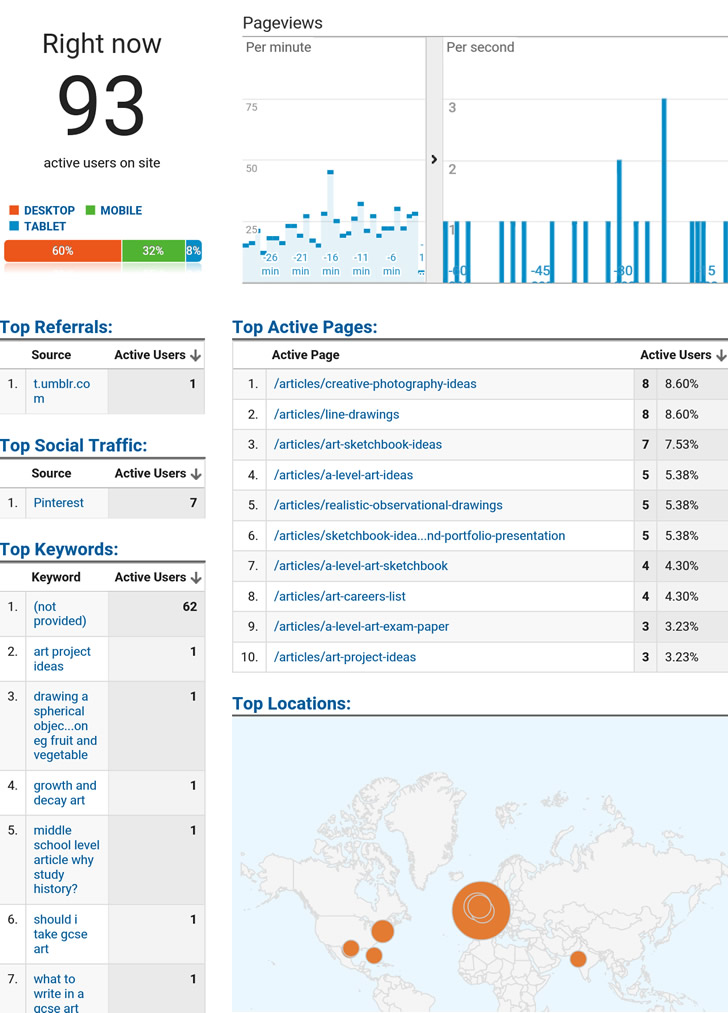This article recommends the best website builder for artists, photographers, writers, and creative entrepreneurs wanting to create a website that is visited by lots of people. It compares several blogging and website platforms, such as Wix, Blogger, Squarespace, Weebly, and WordPress, and is written by an experienced high school teacher with a beginner audience in mind. It concludes with a step-by-step tutorial, showing the exact process used to set up a successful, high-traffic website.

Should I build my own website?
In 2011, I created a website to showcase my artwork and help high school art students gain good grades. One year later, this site was receiving over 1000 visits every day (this became the website that you are reading, the Student Art Guide). If I have learned one thing from this experience, it is that the internet holds enormous value for creative individuals. Making a website is the most effective way to market your work, build a brand, and sell artwork, products, or services. What’s more, creating a website is something that even a high school student (someone with little funds and no prior web design experience) can do.

Websites for artists and other creative people: why they are important
It used to be that great art was discovered by galleries, written manuscripts chosen by publishers. These days, great content is discovered first-hand by ordinary individuals. There is no longer a barrier between the artist and the masses. If you have an online presence – and your work can be found, shared, ‘pinned’ or ‘liked’ – you can achieve a level of recognition that could once only be dreamed of. A single image or blog post can receive thousands of views in a very short time-frame; be seen by vast numbers of prospective clients, admirers, and fans. If you are an artist, photographer, writer (or any other creative entrepreneur), you need to harvest the power of the internet and create your own website as soon as possible.
Why platforms like Instagram, Facebook, Pinterest, Flickr, DeviantArt, Behance, Saatchi Online, Fine Art America, Imagekind, RedBubble, Etsy, and Tumblr are not enough
There are many social media platforms where sharing content is encouraged. These can be helpful for promoting your own work, meeting others with similar interests, gaining feedback, and reaching others via extended social networks. Being an active member of some these sites can be a good idea – and may indeed form a fundamental part of your online strategy – but these sites should complement, not replace, your own website. They should be used as a marketing outpost to drive traffic to your own website, not as a substitute for it.
* A warning about free website builders / free portfolio websites
Many people search Google looking for the ‘best free website builder for artists’ or a ‘free artist website.’ Others look for more specific information, comparing various website builders, such as Wix vs Weebly vs Blogger vs Squarespace vs Google Sites vs Adobe Spark Page and so on. These platforms, along with many others, offer customizable websites, and target those who are looking for an easy way to display their work online (these platforms allow you to set up basic photography portfolio websites or graphic design portfolio websites, for example, usually with higher-priced premium plans marketed alongside). These website builders are typically slick and aesthetically pleasing, with drag-and-drop templates that are appealing for beginners. Indeed, these can be a suitable option for those who wish to create a website to share with family or friends, or a temporary online portfolio, but they should never be used by someone who is serious about getting their website ranked highly in Google and seen by thousands of people every day.
For the best chance of success, you need to create your own original website.
Here’s why:
1. You need total control over the appearance and design.
Aesthetics is important. Websites should showcase your creative work professionally and communicate style and individuality, helping you to stand out from the crowd. This cannot be achieved with a standard page on a free site, using a template that looks like a million others. With your own website, you can select a great design theme and customize this however you like.
2. You need to have an awesome website name, NOT yourname.freeservice.com.
A website name is the starting point for your brand. For as little as thirteen dollars per year you can create the illusion that you are a professional worth investing in. Take your work seriously. With domain names costing so little, there is no excuse for not having your own.
3. You need to optimize your website so that it ranks highly in Google.
If you cannot optimize your content for search engines, your website is left floating alone in cyberspace, relying on endless social media promotion and kind visits from friends. Humans must love your content, but just as important: Google must love it. Google has a secret (and constantly updating) algorithm that they use to determine where websites should appear in the search results. When someone searches for something in Google the search engine carries out a complex calculation (it takes a fraction of a second) to estimate which – of all of the websites in the world – you want to see. According to Search Engine Watch, 33% of people click on the first result shown in Google, 18% on the second result, and even fewer on the third. If your website doesn’t make it onto the first page of results, only a tiny percentage of people will ever find it.

One of the reasons that the Student Art Guide ranks highly in Google is that our articles are comprehensive, highly detailed, and take weeks to write. Another reason is that our content is well-optimized for search engines. This means that Google understands what each page is about, and is thus more likely to rank it highly, so that people can find us. In fact, there is a very good chance that you arrived at this article after Googling “how to make an artist website” or something similar. ? Well, this page is optimized for that phrase, and many other similar terms!
Search Engine Optimization (SEO) is impossible on most free websites and social media platforms. To make matters worse, Google knows whether your website is created using a free platform, and may perceive your website accordingly: as less professional, less serious, and less important.
Unfortunately, sometimes these lower barriers (meant to encourage less techy audiences) can attract some dodgy characters like spammers who look for cheap and easy ways to set up dozens or hundreds of sites that add little or no value to the web. When it comes to automatically generated sites, our stance remains the same: if the sites do not add sufficient value, we generally consider them as spam and take appropriate steps to protect our users from exposure to such sites in our natural search results. – Google Webmaster
In other words, with a free platform, you must work that much harder to convince Google that your content is worth ranking, and, even then, you don’t have the tools to make this easy: you start with a disadvantage. This is one of the most important factors to consider when deciding whether to create your own website.
4. Schools and universities must be able to view your content.
A growing number of schools and universities are blocking all access to social media and free blogging platforms, because, as noted above, these are often used by spammers and those who share dodgy content. Some teachers spend months creating a website using a free platform, only for this platform to be later blocked by their school.
Furthermore, even if you have no direct connection to the education industry, there is a huge advantage to having your work discoverable by educational institutions. For example, students in the UK often find my artist website and study my artwork. Schools then link to my website. Authentic links from relevant websites provide a signal to Google that my website is high-quality (links from educational institutions are considered extra-valuable). This, in turn, makes Google trust my website more and rank it even higher. As noted above, sites that are ranked highly gain more visitors.
5. You need your work to be celebrated, not lost in the crowd.
When someone contemplates buying your artwork (or other products) on a social media platform, or a communal website with multiple sellers, buyers are often distracted by the countless other items showing up in their feed. You want people to be channeled towards your fantastic creations, without others competing for attention. On social or community websites, buyers are easily enticed away.
6. You need to control how you make money from your website.
If you have your own website, earning opportunities are controlled entirely by you. You can sell artwork, products, or services directly from the site. You can add advertising, seek sponsors, recommend affiliate products, embed print-on-demand items, or simply concentrate on building your brand, popularity, and fame. Social media platforms and free website builders often place inappropriate advertising alongside your work or have strict policies governing the way you operate business upon their platform. It is very common for free website builders to plaster their own branding all over your website, attempting to direct your visitors back to them. Generating income from your own website is much easier. If you want to sell artwork online, for example, this can be achieved in a matter of minutes, by adding a ‘buy now’ button beside the work. Alternatively, you can add professional shopping carts or any other commercial feature.
7. You need to measure the number of visitors to your website and other important statistics.
‘Google Analytics’ and ‘Search Console’ are free tools built by Google that are easily integrated with your own website. Most free website builders or social media platforms do not allow you to use these, and offer inferior statistics, if any at all. Google Analytics and Search Console provide in-depth information about those who visit your site. For example, you can see which countries visitors are from, how many minutes they spend on certain pages, which pages they leave immediately, and what they typed into Google prior to arriving at your site. This information is invaluable. It helps to shape and direct your creative work and improve your content for the future.

8. You need the ability to build an email list.
A few years ago, Facebook changed their newsfeed algorithm so that each ‘status update’ made from a Facebook business page was shown only to a small percentage of followers. To have posts shown to more fans, you must now pay money to promote these – even to those people who have chosen to follow your page. As such, the value of having a large Facebook following diminished overnight, crippling many small businesses who relied on Facebook to reach their audience. Similarly, YouTube recently made significant changes to their algorithm, affecting which videos are shown to viewers, making it more difficult for creators to get their videos seen. YouTube also ‘shadowbans’ certain content and demonetizes videos if they deem them to fall outside of their ever-changing guidelines.
Originally, the YouTube subscription feed was a chronological list of videos from all the channels that a person had chosen to “subscribe” to. …[]…However, many video-makers have previously complained that some of their videos have not appeared in the subscription feed, and have questioned whether YouTube manipulates the list to boost viewer retention and advertising revenue. – BBC News (2018)
Social media platforms are businesses that prioritize their own interests. If you have your own website, you have the option for your audience to safely share their email address with you. This means you don’t need to be at the mercy of third parties: you can contact your followers whenever you like. An email list is an asset that you can backup, giving you direct contact with your audience, no matter what happens. Almost all online entrepreneurs regret not starting an email list sooner. An email sign-up box can be added in a couple of minutes to your own website.
9. You need to be able to easily move your website files from one location to another.
If you start with a free blogging platform and then later come to the realization that you should create your own website (as most who are serious about marketing their work online eventually do) moving your content from the free platform to your own website is often difficult and frustrating (it may require manually cutting and pasting every item – recreating the entire website again). Whatever method you choose to create an online presence, it needs to be portable. Moving, downloading, or backing up material from your own website is simple – you have access to every single one of your files and can export these with a few clicks.
10. 100% of the website must belong to you.
When you create a website on a free platform, your website is really a subsection of someone else’s site. Website providers can shut down unexpectedly, taking your content and followers with them. Those who offer free services are particularly vulnerable to collapse. For example, Wikispaces has the following message on their website:
As stated in our communication in January 2018 and subsequent site banners; as of July 31st, 2018 all Free and Classroom Wikis were disabled and are no longer accessible.
In addition, platforms can ban you or delete your files and there is nothing you can do about it. They can suddenly be overtaken by a more successful platform, as happened when Facebook increased in popularity and MySpace dwindled. They can be sold to another company, who may run things totally differently, such as when Flickr was bought out by SmugMug. If you have the potential to create a beautiful, stunning website, it is too risky for this to be at the mercy of another company. It is too valuable of a resource. You need to create your own website.